...Best of Sicily presents... Best of Sicily Magazine. ... Dedicated to Sicilian art, culture, history, people, places and all things Sicilian. |
by Jacqueline Alio | |||
Magazine Index Best of Sicily Arts & Culture Fashion Food & Wine History & Society About Us Travel Faqs Contact Map of Sicily
|
Born at Angers Castle (Angers, Anjou) in France in October 1165, blond-haired Joan was the seventh and youngest surviving child of King Henry II of England and his queen consort, Eleanor of Aquitaine. (Henry fathered illegitimate children as well.) As one of their three surviving daughters, Joan (or Joanna) spent her earliest years in England but mostly in France, where her mother lived in Poitou, effectively separated from her father. Joan was attractive - fair with brown but faintly reddish hair - and, according to what few accounts exist, rather intelligent even as a child. Her brother, the future Richard I Lionheart, was the only one of her siblings known with certainty to have visited her in Sicily; King John spent more time in England. As a young girl at the Abbey of Fontevrault, Joan learned English, Norman French, and at least the rudiments of Latin, in addition to a range of skills deemed appropriate to the mistress of an aristocratic household. Like Joan, her sisters were betrothed to European monarchs: Matilda wed the Duke of Saxony in 1168 and Eleanor married the King of Castile in 1177. In the case of Joan's marriage to William, however, there was a very special Norman link. Shown at the right is the lion depicted near the throne in mosaic in the palatine
chapel of the Royal Palace of Palermo; the image, associated with
the Norman dynasties of Sicily and England, may have an Arab
or Byzantine origin. Heraldic ambiguity is not the only anomaly in Joan's
A great-grandson of William I "the Conqueror," the French-born Henry was Norman to the core, often occupied with his dominions in France, some of which he ruled by virtue of his marriage to Eleanor, an heiress. So busy was he with foreign matters that in 34 years as King of England, Henry spent a mere 14 years in that nation. Eleanor was the divorced consort of King Louis VII of France (and kin to both her husbands), who later fought a brief war against Henry. Such were the complexities of medieval court life, shadowed by equally complicated international alliances in which inter-dynastic marriages were thought to cement loyalties. (Officially, Eleanor's marriage to Louis was annulled for close consanguinity, but in reality the French monarch seems to have been most worried about his wife's propensity for producing daughters, rather than any canonical formaility.) Henry II is noted for his legal and administrative reforms, leading to the development of fundamental English institutions such as common law and trial by jury. His Constitutions of Clarendon (1164) re-established royal prerogatives not unlike those embodied in the "Apostolic Legateship" of the Kings of Sicily. A coincidence, perhaps, but contact between the "Norman" courts of London and Palermo were remarkably close considering the geographical distance between them. In view of the increasing power of the Crown and its juridical institutions, a legal dispute with the Church was inevitable. This fostered ill feeling with the Archbishop of Canterbury, Henry's former friend and chancellor, Thomas Becket, leading to Thomas' exile from 1164 to 1170. The archbishop's close relatives were likewise exiled, and some found refuge in Palermo as guests of the King of Sicily, William I, later referred to as William "the Bad." (By the middle of the twelfth century, many Norman families had relatives in both Sicily and England.) Joan's relationship with her father probably left something to be desired, and this may partly account for her later devotion to Saint Thomas Becket, the archbishop her father's nobles murdered. True, Henry did public penance for this act at Canterbury in 1174, but this could not attenuate the impact of such dramatic events on an impressionable girl raised in a society where respect for religious institutions was part of daily life. The mosaic icon of Saint Thomas Becket in Monreale Abbey is the earliest public image of the saint known to survive, and several twelfth-century churches in Sicily are dedicated to the saint soon venerated across western Europe. In 1173, coincidentally the year Becket was canonised, Joan's mother, the strong-willed Queen Eleanor, led a revolt against King Henry II, supported by their three surviving sons (Henry's illegitimate sons supported their father). Following the failed rebellion, Eleanor, at the age of 50, was imprisoned (in "house arrest" in a castle) for what was to stretch into a 15 year incarceration, and Joan was living with her at Winchester in early 1176 when a Sicilian delegation arrived to confirm, among other things, the exceptional beauty of the ten year-old princess, before formally requesting her hand from Henry. William himself was reasonably attractive, of average height with reddish hair. His father was William I, his grandfather Roger II. As a young girl, Joan had been formally betrothed to William II on the
basis of a prior agreement (in 1168) and provided with a feudal dowry in
Italy. In the event, the Sicilian Hautevilles were not haunted by the money
problems that plagued the English "Plantagenets." In the 1170s,
the royal tax revenue of Palermo, a prosperous and cosmopolitan city of
some 200,000 people, probably exceeded those of all England. It wasn't long
after their defeat of Saracen (Moorish) forces at the Battle of Messina
in 1061, five years before the Battle of Hastings, that the "poor cousins"
of William the Conqueror had emerged as the wealthiest sovereigns of Europe,
standing among the most powerful rulers of the Mediterranean, with control
over southern Italy, Sicily, Malta and (occasionally) parts Led by Bishop John of Norwich, the embassy of King Henry II arrived in Palermo in mid-1176 in advance of Joan's party, which stayed behind in England. The Bishop of Winchester handled details for Joan's voyage, and Henry met William's delegation in August. Joan's voyage to Sicily, accompanied by a large suite of ladies-in-waiting, knights, clergy and various retainers (everything from cooks and seamstresses to grooms and blacksmiths), was typical of the travels of royalty and the highest-born nobility in the Middle Ages. What distinguished it was the exceptional youth of its protagonist. Following a feast, Joan bid farewell to her mother and father. The trip began with the short stretch from Winchester to Southampton, escorted by the archbishops of Canterbury and Rouen, the bishop of Evreux and her uncle, Hamelane, natural brother of King Henry. Then Prince Henry, her oldest brother, the 20 year-old heir apparent, accompanied her across the Channel and into France to Poitiers. There she was met by her brother Richard, who escorted her through the Duchy of Aquitaine (nominally his), across the allied County of Toulouse to Saint Gilles Port, where Bishop Richard Palmer welcomed her in the name of the King of Sicily. Twenty-five Sicilian ships awaited the young princess. It was mid-November, and the gales had already decimated the fleet of Bishop John of Norwich, returning from Messina with King William's gifts for his future father-in-law. (It seems typical of what King Henry believed to be his own poor luck that most of the royal treasure destined for him was lost.) Some six weeks later, Joan's suite, following the coast, finally arrived at Naples, then the fourth-largest city of William's kingdom (which encompassed almost half the Italian peninsula). She was ill - probably seasick - and the remainder of the journey, with the exception of the crossing of the Strait of Messina, was completed overland in early January through Campania into Calabria. She crossed into Sicily and reached Cefalù in the last days of January. The journey of a prince with a small escort of knights would have been quicker, but more time was required when travelling with a large group of "civilians" including numerous women, of whom Joan was probably the youngest. More than half of Joan's journey, and nearly the entire overland segment, traversed the domains of her father and her future husband. The evening of 2 February 1177, William greeted Joan. The future queen was riding a docile palfrey, and met William at one of the city gates - probably in the Kasr district not far from the palace. The city was splendidly illuminated, and William accompanied his fiancée and her suite to their temporary quarters - for the ladies possibly the Zisa, one of the other fortified palaces in the vast Genoard royal park. The child bride married William II "the Good" at Palermo Cathedral on 13 February 1177 (Monreale Abbey was not yet complete) and was then annointed and crowned Queen of Sicily by her countryman Walter of the Mill, Archbishop of Palermo, in the Palatine Chapel (shown here). She was just eleven, her husband now twenty-three. Strictly speaking, she was "queen consort," as she was not a sovereign in her own right and was not meant to ever actually rule. Nevertheless, medieval queens of her era sometimes found themselves in positions of power, particularly in the absence of their husbands. A typical example was William's mother, Margaret of Navarre, widow of William I. Still alive to witness the wedding in 1177, she had served as Queen Regent during her son's minority, and continued to exercise influence following the coronation of her very young daughter in-law. Despite a few surprising similarities, Palermo and Sicily were very different
from London and England, and this cannot but have made an impact on Joan
and her suite of ladies-in-waiting, accustomed to the lifestyle - and even
the flora and fauna - of England and northwestern France. (Could she speak to us today, Joan would recognise the Byzantine-style mosaic shown here, adorning a wall in the Royal Palace in Palermo, based on actual scenes in the royal gardens
and zoo nearby, complete with palms, peacocks and leopards.) Norman-Arab architecture, a true Romanesque synthesis of Northern European and North African styles,
with a strong Byzantine influence, reflected the culture of the people themselves.
Sicily's Anglo-Norman bishops included Walter of the Mill, Richard Palmer
and Hubert of Middlesex, with canons bearing names Superficially, the essentially Romanesque style of the castles and cathedrals was Norman enough (and two-light windows abounded), though embellished by Byzantine elements and interpreted in Moorish style. Indeed, some of the smaller churches strangely resembled mosques. Along the winding, narrow streets were houses made of stone and tiles rather than timbers and thatch. It was all decidedly Mediterranean; medieval Palermo looked more like Jerusalem than London. Owing to its Sicilian, Greek, Italic and Arab origins, the cruisine was different, too. In daily life, silk and cotton took the place of wool, paper replaced parchment, honey surrendered to the joys of sweet sugar, and a unique hybrid of Latin, Greek and Arabic (with just a touch of Norman French) was becoming popular among a new generation of people called "Sicilians." In the countryside, the feudal barons were an unruly, and often illiterate, Norman lot, whose chivalry and loyalty were encouraged by a royal bodyguard of Saracen soldiers. What would Joan's father have thought of a country where there was a separate legal code for each ethnic group? And if all that were not enough, there was the personal harem of the young queen's husband, William "the Good," full of shapely, dark-haired, ebony-eyed Arab women who spent their free time bathing and weaving - a holdover from the days of the Emirs of Bal'harm, as the Arabs called Palermo. The exotic ambience fashioned by the flavors and pleasures of this eccentric island in the sun, presented as a fait accompli to a girl of tender years, was a long way from the one Joan had known. One chronicler mentions that Joan bore a son, called Bohemund, in 1182, but that the child died in early infancy. She may also have had miscarriages during this period. Her father, Henry II, died in July 1189. In November of the same year, Joan was widowed when William died, following an illness, in Palermo, at the age of thirty-six. Though he was, in many ways, a sovereign typical of his era, William's expansionist Mediterranean politics and unenlightened local government have led historians to regard him as a mediocre monarch. He was also an heirless one. The only potential legitimate heir was William's aunt, Constance,
a posthumous daughter of King Roger II now wed to the Emperor Henry VI of
Germany (by whom she eventually bore a son, Frederick II). The Sicilian Crown
was contested, claimed by Tancred, an illegitimate
grandson of Roger II who for a few years managed to impress the advantages
of his leadership upon the unruly Norman barons of southern Italy. Knowing
Joan to support the dynastic claim of Constance These facts did not set well with her brother, Richard, at thirty-three now King of England and making his way to the Holy Land for a Crusade. From Salerno, Richard made it known that he wanted his sister freed and her revenues restored immediately. Furthermore, he wanted her to be provided with the golden throne which he believed to be her right as a Norman queen. His threats were not idle ones; his army of Crusaders probably could have defeated Tancred's disloyal - though enfeoffed - Norman barons, and he may have had his own designs on Sicily. He may also have been annoyed that Tancred refused to honour his successor's promise to the late King Henry of ships for the present crusade. Richard indicated that he would not leave Sicily until his demands were met. Arriving at Messina in September 1190 to meet King Philip II of France, Richard ordered his troops to construct a fort of timbers on a hill overlooking the city where he would be staying for several months. Native speakers of French, the three kings - Richard, Philip and Tancred - were equally fluent in the cynical language of the sly and opportunistic medieval European sovereign. Truth be told, Philip, contemporary of the late King Henry, was (if we are to base our judgement on his politics over previous decades) probably the least honest of the three kings present in Sicily in the Autumn of 1190, while Richard was the most colorful and Tancred, owing to trying circumstances, the most dour. It would be unfair to attribute to Tancred an excessively negative character based solely on what seems to have been his politically necessitated treatment of Joan. Nevertheless, the young English king was known to be fond of his youngest sister, and he was well able to enforce his threats. Tancred complied immediately, though in the end he kept Mount Sant' Angelo and compensated Joan for its loss, and Joan arrived at Messina a few days later. Richard took her to an abbey founded by Roger I a century earlier near Bagnara, in Calabria across the Strait of Messina, and left her under the protection of a strong garrison. Returning to Messina, Richard 's army occupied an Orthodox monastery for lodging. This was only the most recent in a series of English outrages that offended the citizens of the predominantly Orthodox city, who were already annoyed at things like the English knights' obviously lustful treatment of the local women. A popular revolt ensued. In response, the English (and some of the French) sacked the city, and Tancred, in nearby Catania, could do nothing to stop the violent riots, though Richard finally restored order. Meeting "en famille" at Catania a few days later, Tancred and Richard made peace. Tancred's dynastic position was difficult, and an alliance with the English king might prove effective in curbing the ambitions of Constance and her German husband, keenly watching Sicilian events from afar. In April, Eleanor (who Richard had freed following his father's death) arrived at Messina with Berengaria of Navarre, Richard's future wife, to visit her son and daughter; Eleanor had called on King Roger II at Palermo forty-four years earlier while returning from a pilgrimage (actually a crusade) to the Holy Land. Now sixty-nine, Eleanor, visited Sicily briefly before returning to England. Joan left with Berengaria to visit Palestine, followed by Richard. In the Holy Land, Richard proposed that his sister marry Saladin's brother, an idea which fortunately was cast aside. (However, the incident does lend credibility to the thesis that Richard "liberated" his sister from Tancred not out of fraternal affection but as a pretext for a dispute which might justify his own full-scale conquest of Sicily.) In December 1192, returning from Palestine, Joan and Berengaria (now Queen of England) visited Palermo to be received en fête with a properly royal reception from Tancred and his wife, Sibylla. Past acrimonies, if indeed they were ever very serious, had been set aside. The two young queens then set off to France and England. Joan preferred France, where she spent some time among the cloistered nuns of the order of Fontevrault. In October 1196 she wed, as his fourth wife, Raymond VI, Count of Toulouse, a cousin (through her mother), by whom she bore three children, namely Raymond (VII) in 1197 (died 1249), Wilhelmina in 1198, and Richard in 1199 (died in infancy). Joan died in childbirth in September 1199, still a young woman. She is buried at Fontevrault Abbey (Fontevraud, Berri, France) with her mother, Eleanor, who died in 1204, her father Henry, and brother Richard. Count Raymond VII of Toulouse named his daughter, Joan (1220-1271), for the mother he barely knew. Joan is commemorated in Elizabeth Fries Ellet's Scenes in the Life of Joanna of Sicily, published in 1840. About the Author: Historian Jacqueline Alio wrote Women of Sicily - Saints, Queens & Rebels and co-authored The Peoples of Sicily - A Multicultural Legacy. | ||
Top of Page |
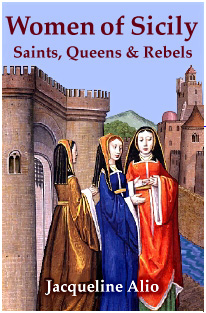
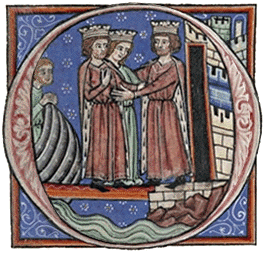 She remains a footnote
to Sicilian history, her role perhaps close to that of the typically sheltered,
if not passive, medieval European noblewoman, bound by a sense of duty all
but abandoned in our modern world. Nothing like the bold image of her mother,
the crusading Eleanor of Aquitaine, the strong-minded
She remains a footnote
to Sicilian history, her role perhaps close to that of the typically sheltered,
if not passive, medieval European noblewoman, bound by a sense of duty all
but abandoned in our modern world. Nothing like the bold image of her mother,
the crusading Eleanor of Aquitaine, the strong-minded 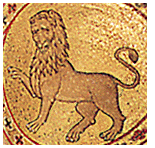 familial identity. In retrospect, her father's dynasty is
called "Plantagenet" (from the nickname of Joan's grandfather Geoffrey of Anjou), a term
not used as the royal family's formal surname in the twelfth century
but linked to them by later historians. As king, Richard I used a coat of arms with three
lions, but there is no evidence that any heraldic device was ever formally
associated with Joan herself --though her Sicilian husband's family used
such identifying symbols as the the fleur-de-lis and the lion "passant
guardant."
familial identity. In retrospect, her father's dynasty is
called "Plantagenet" (from the nickname of Joan's grandfather Geoffrey of Anjou), a term
not used as the royal family's formal surname in the twelfth century
but linked to them by later historians. As king, Richard I used a coat of arms with three
lions, but there is no evidence that any heraldic device was ever formally
associated with Joan herself --though her Sicilian husband's family used
such identifying symbols as the the fleur-de-lis and the lion "passant
guardant." 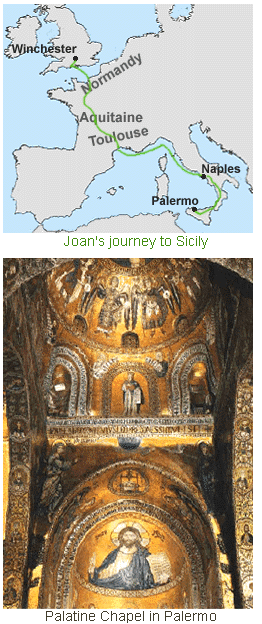 of Africa and
the Balkans. William ascended the Sicilian Throne upon the death of his
father (William I) in 1166.
of Africa and
the Balkans. William ascended the Sicilian Throne upon the death of his
father (William I) in 1166. 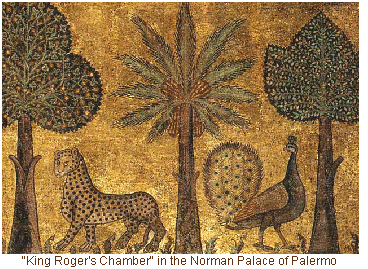 like John of Lincoln
and Richard of Hereford, as well as dozens of others unknown to us. Yet, a growing Latinisation and the presence
of a few Anglo-Norman clerics could not erase certain eternal Eastern (Orthodox)
traditions, and much of Sicily was Muslim. William II commissioned Monreale
Abbey as a Latin (Catholic) church in the Benedictine tradition, yet his
likeness (in mosaic) on its wall is just as Byzantine as earlier representations
of his father (William I) and grandfather (Roger II), showing typically
"Constantinopolitan" crown and robes. Palermo itself was largely
Arab, with souks, mosques and veiled women. Adding to the mix were large
Jewish and Orthodox Christian districts, and with the constant flow of traders
and other travelers (as well as visiting scholars like
like John of Lincoln
and Richard of Hereford, as well as dozens of others unknown to us. Yet, a growing Latinisation and the presence
of a few Anglo-Norman clerics could not erase certain eternal Eastern (Orthodox)
traditions, and much of Sicily was Muslim. William II commissioned Monreale
Abbey as a Latin (Catholic) church in the Benedictine tradition, yet his
likeness (in mosaic) on its wall is just as Byzantine as earlier representations
of his father (William I) and grandfather (Roger II), showing typically
"Constantinopolitan" crown and robes. Palermo itself was largely
Arab, with souks, mosques and veiled women. Adding to the mix were large
Jewish and Orthodox Christian districts, and with the constant flow of traders
and other travelers (as well as visiting scholars like 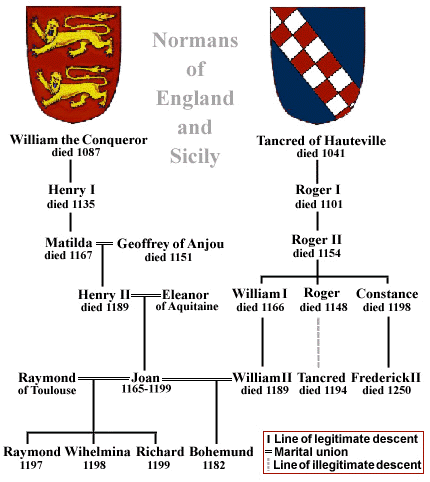 of Hauteville, and probably
fearing her influence among the Sicilians, Tancred marginalized her (restricting
her movement around the Kingdom), depriving the Queen of her feudal revenue
from the County of Mount Sant' Angelo she had received at marriage.
of Hauteville, and probably
fearing her influence among the Sicilians, Tancred marginalized her (restricting
her movement around the Kingdom), depriving the Queen of her feudal revenue
from the County of Mount Sant' Angelo she had received at marriage.